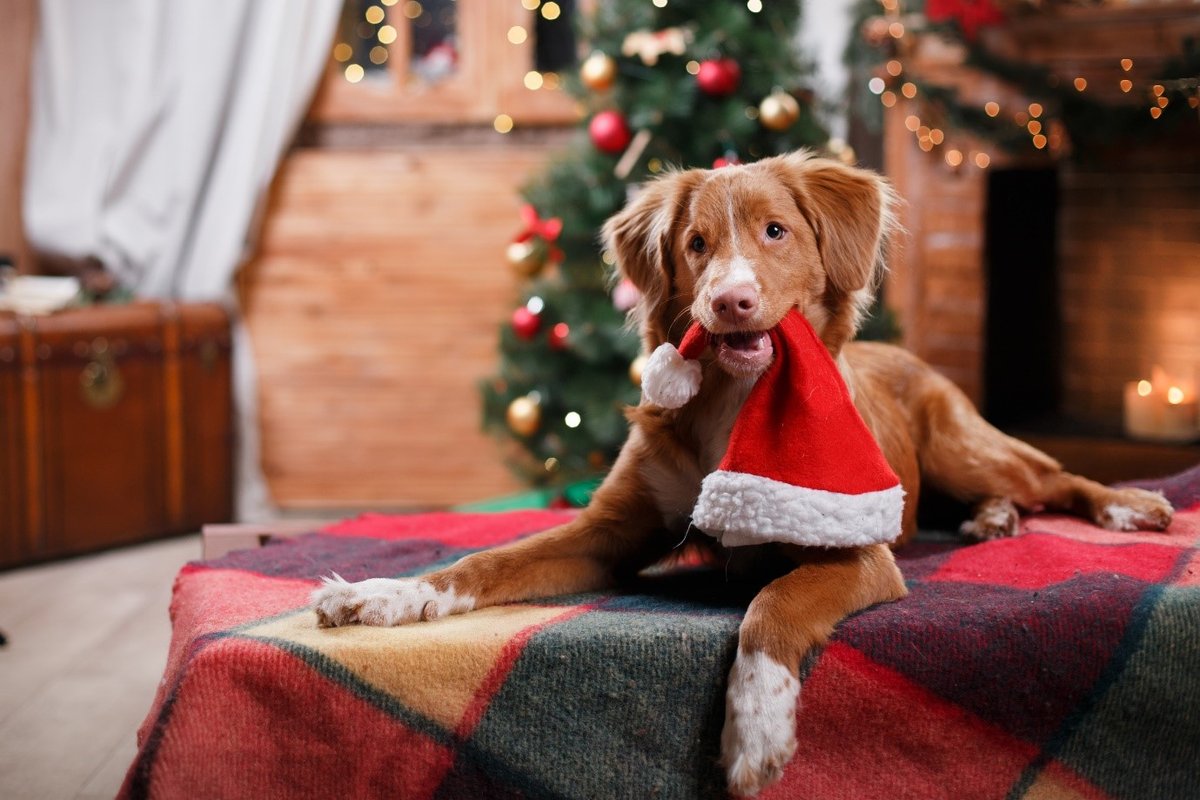While decorating your house for Christmas is both exciting and joyous, for dog owners it can become rather worrisome, as there are many hazards that could harm your beloved pup. To help you dog-proof your house and decorations this Christmas, here is a list of the top hazards to lookout for and advice on how to avoid taking your dog down to the emergency vets…
- Anchor Down Your Christmas Tree
Oftentimes, our dogs see Christmas trees as a giant, sparkly and fascinating toy… Which sounds sweet until they decide it’s playtime and pounce onto the tree, bringing it crashing to the ground! If you don’t want to risk all your time and effort you spent in decorating the tree to be destroyed and all your precious ornaments breaking, we highly recommend that real Christmas trees are bolted to a sturdy, solid base and that artificial Christmas trees are secured correctly into the base provided (it helps to read the instructions!).
- Be Careful with Christmas Lights
Dogs are drawn to twinkly colourful lights like bulls are to the colour red, which can be highly dangerous as a dog’s immediate reaction is to chew the cables. In doing so, they may suffer from internal injuries by swallowing the glass bulbs or even electrocute themselves – which can be fatal. Thus, be sure to fasten your Christmas lights to the tree and ensure any cables and electrics are out of reach!
Bright lights and flashes may also cause your pooch to become erratic, as it incites an innate predatory behaviour within them. Therefore, it is best to choose simple lights that don’t flash or change colours, for the sake of your dog’s wellbeing (and your own!).
- Ensure Ornaments Are Not Accessible
As pretty as they are, Christmas ornaments can be lethal for dogs; from tinsel that can cause gastrointestinal blockages to ornaments can cause cuts in their mouth, throat and digestive system when chewed. Therefore, it is essential to put your dog’s safety above aesthetic at Christmas.
One obvious way to keep your dog safe from potentially dangerous ornaments is by keeping all decorations out of range – this may mean hanging ornaments up high or even keeping the bottom of your Christmas tree undecorated. Alternatively, there are many dog-friendly ornaments to choose from that are just as lovely, such as personalised wooden baubles or charming felt decorations.
- Pick Safe Christmas Plants
Thankfully, the traditional Christmas tree is not poisonous for dogs – although it may pose some risk if the loose pine needles are swallowed (see tip #7).
Holly – While it may look wonderfully Christmassy along the stair banister or above the fireplace, holly can make your dog rather sick if eaten; with symptoms such as diarrhoea, vomiting and exhaustion.
Mistletoe – Mistletoe is known for sharing a loving kiss, yet it may have less desirable side effects if your dog decides to taste it. Another poisonous plant for dogs, mistletoe can cause confusion, unusual behaviour, decreased heartbeat, slow breathing, vomiting and diarrhoea.
Despite it being strongly advised to avoid using real holly and mistletoe to decorate your home, if you do find yourself in the upsetting predicament wherein your pup has tasted either of these plants, take them to your vet immediately.
- Keep Presents Out of Reach
Like children on Christmas morning, dogs are just as inquisitive and excitable when it comes to opening presents… even if the gifts aren’t their own(!). If you’d prefer not to find that your pooch has undone your wrapping and has chewed at every gift in sight, it is best to put your Christmas prezzies in a safe place that your dog can’t access, rather than under the tree.
- Hide All Chocolates and Sweets
While we seldom leave chocolates and sweets lying about the rest of the year, at Christmas, our households tend to be filled with sweet treats for all the family to share – with the exception of our dogs. Why? Because chocolates and sweets are dangerous for our furry friends.
Chocolate is highly toxic for dogs; even though it is rarely fatal, it can cause serious illness for our pups. The most common signs of chocolate poisoning include: vomiting, diarrhoea, tremors, restlessness, increased thirst, elevated heart rate and seizures. While not as severe, if your dog consumes sweets, it may lead to vomiting, diarrhoea, gas and discomfort – and, in some cases, could cause serious illness.
So, if you want to avoid a trip to veterinary A&E this Christmas, it’s best to keep all sweets and chocolates out of reach!
- Vacuum Loose Tree Needles
Rather unsurprisingly, even though real Christmas trees aren’t poisonous for dogs, the sharp pine needles and leaves won’t agree with their digestive system and may cause a significant amount of discomfort – which is the last thing you’d want for your pooch this Christmas! As dogs are innately inquisitive animals, it is likely that if lots of pine needles are on the floor your pup will explore them with their mouths. Therefore, it is best to regularly vacuum the pine needles to prevent your dog from becoming unwell at Christmas.
By following this guide, we are sure that you, your family and your furry friends will have a happy and safe Christmas! Please remember, if you have any concerns regarding your dog’s behaviour or wellbeing, call your vet for advice and help.


